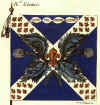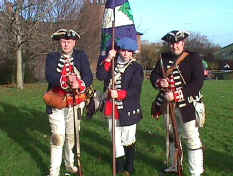 The
regimental The
regimental
Colour of the Royal Ecossais
The Royal Ecossais was raised by John Drummond in 1744 and
disbanded 1763.
Alan Breck Stewart is generally held
to have been the murderer of Colin Campbell of Glenure,
however, Stevenson's fictional character is more closely
based upon John Roy Stewart, himself at one time an officer
in the Royal Ecossais.
Cliquetez
ici pour lire cette section en français =>
Raised by John Lord Drummond of Perth with a capitulation
dated 3rd December 1743 followed by a royal ordnance dated
1st August 1744. Their organisation was to be based on that
of the Irish regiments ,to be made up of 11 companies of
fusiliers and 1 of grenadiers each of 50 men plus officers
for a total of 660 effectives. The officers and men used
to form the regiment came from several different sources,
firstly from Scotsmen serving in the Irish regiments, Scottish
exiles living in France together with recruits smuggled
out of Scotland. With an effective of 500 men and officers
assembled at St.Omer, with John Lord Drummond as lieutenant
colonel, (as for all Royal Regiments, the King of France
was always the colonel ) although Lord Drummond wrote on
the 29th December 1744 that he was missing only 10 men to
complete the regiment.
This regiment,
as many other foreign regiments in tjhe French Army were
not mercenaries as is often claimed, they were more often
than not political or religious refugees who could not safely
return to their homeland for fear of persecution.
In the spring of 1745 the regiment
was sent to join the army of the Marshal de Saxe in Flanders.
They started off their career at the siege of Tournai which
started on the25th of April and stayed until the end on
the 20th of June, said to have been at the Battle of Fontenoy
on the 11th of May but I have found no definitive proof
of this, their name does not figure on any official documents,
but as their is some proof that John Lord Drummond was there
as an observer with the Irish brigade ( he had previously
been a captain in the Regiment de Rooth ) and this may be
the reason for this error. Now under the command of the
Count Lowendahl they were at the sieges of Gand and Audenarde
in July, Ostend in August and Nieuport in September.
Louis XV pushed by both the Marquise
De Pompadour and the need to relieve the pressure on his
armies in Flanders decided to send a small expeditionary
force of about a 1,000 men to Scotland to help Charles Edward
Stuart to try and recover his throne. This force was made
up of the regiment Royal Ecossais, 50 men from each of the
Irish regiments and Fitzjames regiment of horse, the majority
of which were captured at sea by the British Navy.
The Young Pretender raised his Standard
on the 19th of August 1745 and the Royal Ecossais took ship
on the 26th of November 1745 and landed in Scotland on the
7th of December at Montrose to reinforce the Pretenders
army; They were authorised to raise a 2nd battalion in February
1746.
Some of the regiment were present
at the Battle of Falkirk on 17th of February 1746 at the
rear of the center of the second line with Bonnie Prince
Charlie while the rest were at the siege of Stirling Castle
were they suffered heavy casualties, the Jacobite forces
lost 600 of their best men, mostly the “French Piquet’s”!.
The regiment had a strength of 350 men at the Battle of
Culloden on the16th of April 1746 were they were in the
second line and later they helped to cover the retreat of
the Highlanders right wing, an attempt by Argyll Militia
to interfere was pushed aside but in the skirmish the two
battalions became separated and one , probably the 2nd battalion,
was caught and surrounded by British Dragoons and forced
to surrender in Inverness, the other one, together with
their colours continued its retreat towards Ruthven Barracks
and did not surrender until the 19th of April.
The troops of the 1st battalion as
uniformed regulars were treated, albeit harshly, as prisoners
of war and did not suffer the same fate as many highlanders,
and were imprisoned in the Barracks at Ruthven, but those
of the 2nd battalion having been raised in Scotland were
not that well dressed and as such were considered as rebels,
all but one were eventually released and all of the survivors
were exchanged as prisoners of war and sent back to France
where the regiment was rebuilt and Louis Drummond of Melfort
became the new Lieutenant Colonel following the death of
John Lord Drummond. The expedition was a disaster for Scotland
but Louis XV had won a strategic victory as the English
had had to withdraw frontline troops from Flanders to combat
the Rebellion and so relieved the pressure on the French
Army in Flanders. In the spring of 1747 the regiment rejoined
the army of Count Lowendahl and fought at the siege of Berg
Op Zoom and participated in the last victory of the war,
the capitulation of Maëstricht on the 7th of May 1748.
The two battalions had been consolidated in August 1747
into one battalion. They were reinforced on the 20th December
1748 when the Regiment of Albany was disbanded and the soldiers
of Scottish origin were redistributed between Royal Ecossais
and the Regiment of Ogilvy. On the12th of February 1749
the fusilier companies of all Scottish and Irish regiments
were reduced from 50 men to 35, their peace time strength
.
In 1756, at the start of the Seven
Years War the regiment was in camp at Calais and from there
they were sent on coast guard duties, at one time they were
at Belle Isle until May 1760 when they were sent to join
the army of Marshal De Broglie where they defended Marbourg
and then Villingshausen until the end of the war.
The end of the war was a time
of major changes and the need for econmies and many regiments
were disbanded or amalgamated and Royal Ecossais which had
lost most of its Scottish origins due to the difficulty
of finding Scottish recruits and was disbanded and the troops
of Scots or Irish origin were transferred to the Irish regiment
of Bulkeley in December 1762.<=
Cliquetez ici pour lire cette section en français
Some quotes...
"In addition to red coated Irish
Picquets Lord John Drummond, the commander of the French
Troops, also brought some 400 men of his own regiment, the
Royal Ecossois. This was a Scottish unit raised in 1744,
for which Drummond was given permission to raise a second
battalion in Scotland. A couple of officers and some men
can certainly be identified as having joined the regiment
after its arrival in Scotland, but the projected second
battalion never materialised. Unlike the Irish regiments
there was no polite fiction that these Scots soldiers were
merely 'on loan' from the British Army and consequently,
instead of the full-skirted red coats worn by the Irish,
the Royal Ecossois had a rather dashing blue uniform."
- Stuart Reid, 'Like Hungry Wolves'
 A
nineteenth century depiction of the Royal Ecossais. On examination
this appears to be the uniform worn by the regiment post
1752, when a standardisation of all French Uniforms took
place. Hence change to long coats and white facings. A
nineteenth century depiction of the Royal Ecossais. On examination
this appears to be the uniform worn by the regiment post
1752, when a standardisation of all French Uniforms took
place. Hence change to long coats and white facings.
UK re-enactors who portray the
Royal Ecossais...
Fusiliers, Regiment Royal Ecossais
"This Scottish regiment in
the French service initially stood in the second line at
Culloden, and later some fought a desperate rearguard action
against the British cavalry before being forced to surrender.
Others, however, led by Major Hale, succeeded in escaping
to Ruthven Barracks and did not surrender until 19 April.
Originally it had comprised only a single battalion, but
Lord John Drummond had been authorised to recruit a second,
and appears to have picked up quite a number of recruits
after landing in Scotland. Some of these recruits later
had great difficulty in being accepted as prisoners of war
rather than as rebels.
One of them was Lieutenant Charles
Oliphant, a customs officer from Aberdeen, and his unusual
uniform was described by one of the witnesses at his trial
in 1747 (he was found guilty, but pardoned on condition
of emigrating to America): 'Prisoner wore the uniform of
Lord John Drummond's officers, viz; short blue coats, red
vests laced with bonnets and white cockades.' A drover named
John Gray also described Drummond himself wearing the same
uniform, although he helpfully added that the coat itself
was also laced. This style was of course very Scottish,
and the grenadier company even went as far as to wear kilts
in place of the white breeches depicted here. By 1752, however,
the battalion or fusilier companies were more conventionally
dressed in full skirted coats, and tricorne hats with white
lace. The French infantry of the period seem to have worn
white gaiters with all orders of dress; and wemay presume
that this regular unit may have been equipped with the Modele
1728 musket".- Stuart Reid, 'Like Hungry Wolves'
The above description of the uniform
contradicts the depiction of a fusilier in the Osprey Campaign
Series: Culloden 1746. In that illustration the soldier
has a long skirted coat and the presumtion is that this
is a later uniform either interim dress before the move
to long skirted coats in 1752 or a confusion with that change.
"The other significant component
arrived only after the [Jacobite] army was well established.
This was the rather speculative contribution of the French
government and comprised a number of detachments, or 'picquets',
from the various Irish infantry regiments of the French
army, together with a single Scottish regiment, the Royal
Ecossais. A regiment of cavalry, Fitzjames's Horse, was
also sent. Unfortunately, not all of these troops actually
arrived as planned; a significant proportion were captured
on route to Scotland by the Royal Navy. Only about a squadron
of Fitzjames's Horse reached Scotland and even they had
had to be mounted at the expense of Scottish units; the
French, being regular troops, were given a higher priority
for the use of the army's limited resources. Despite being
regular troops, the French contingents' lack of eventual
numbers ensured their presence had little influence over
the final fate of the Jacobite Army. Ironically, it was
their professional discipline that allowed them their principal
contribution to the Rebellion when they covered the Jacobite
rear during the final stages of the Battle of Culloden."
- Allan L. Carswell "'The Most Despicable Enemy That
Are' - The Jacobite Army of the '45" essay from '1745
- Charles Edward Stuart and the Jacobites', edited by Robert
C. Woosnam-Savage.
|




